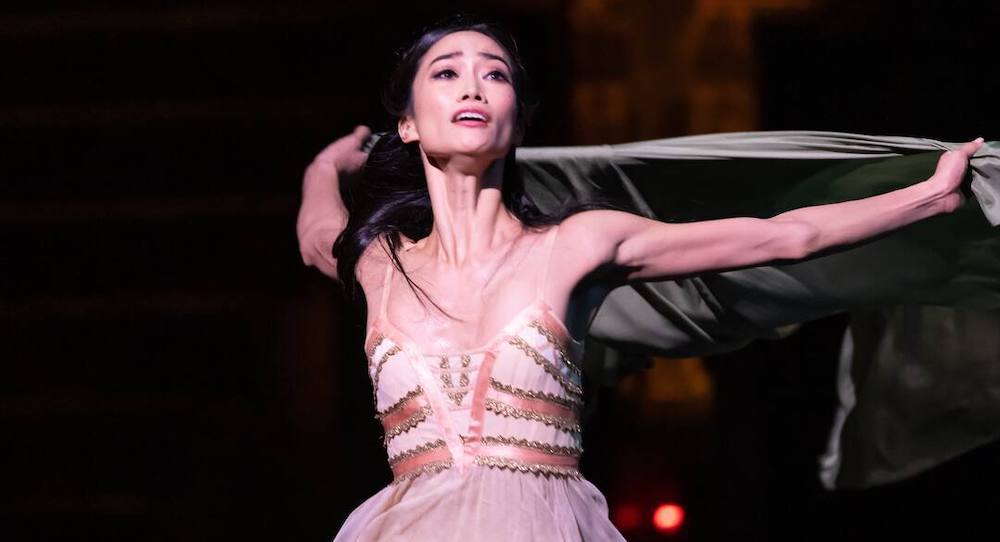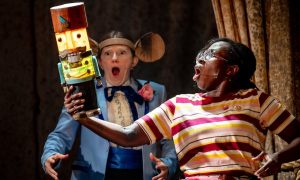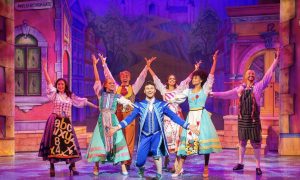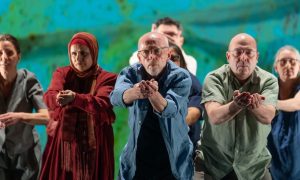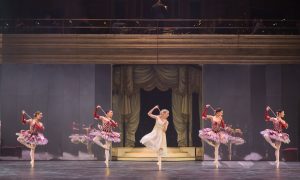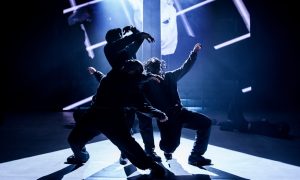Cinema relay from Royal Ballet and Opera, London.
23 March 2025.
‘The greatest love story ever told – through ballet.’
Sound issues at the beginning of The Royal Ballet’s cinema relay of Romeo and Juliet meant audiences were not able to hear the opening interview with the Stage Manager. Frustrating, but it was sorted before the masterpiece began: A rich and exquisitely choreographed exploration of Kenneth MacMillan’s interest in people and emotions, coupled with Shakespeare’s profound commitment to bringing matters of the heart to centre stage. A match made in heaven was about to unfold before us on the stage.
As usual with cinema relays, the camera sweeps right into the orchestra pit for the arrival of the conductor, and the beginning of the overture. It is a unique opportunity to view musicians’ tremendous skill.
Our packed opening scene in the Town Square captivates immediately with its fast-moving action. A boisterous Romeo Montague – played by Vadim Muntagirov – and his equally youthful and arrogant friends dance vivaciously with the harlots. They antagonise the Capulets, and vice versa, resulting in furious sword-fighting, a pile of dead bodies and admonishment from the Prince of Verona. If you blinked, you would definitely miss something!
Scene 2 introduces a playful Juliet, by Fumi Kaneko. Nurse indulges her childish and very-watchable game of hide and seek with her doll. Juliet shyly retreats when her parents enter to introduce her to Paris. An exacting scene highlighting Juliet’s youth, the expectations of her parents and the contrast to come of the rapid escalation to maturity when Juliet falls in love with Romeo. Kaneko plays this role with outstanding finesse.
Throughout the entire three-act ballet, the camera’s intensely close proximity embraces the cinema audience as witnesses to all the action — the villager’s distaste of the harlot dancers, the excitement of the surging crowd during the fast and impressive sword fighting, and the moment Romeo and Juliet’s eyes met.
The masked ball with its infamous Dance of the Knights did not disappoint — the rich costumes, the hierarchy of family members, and the stirring powerful music as they walk towards the audience. This ballet is as much about the acting as it is the dancing, where ballet technique is used to convey the emotions.
Devoted at first sight, Romeo dances for Juliet, and she for him. They only have eyes for each other. Muntagirov’s flamboyant charm and athletic execution is thrilling, and Kaneko’s expressive maturity in her movement is heart-rending as she announces the end of Juliet’s childhood. The chemistry between Muntagirov and Kaneko builds towards the anticipated balcony scene.
MacMillan leaves nothing out. Originally created for Lynn Seymour and Christopher Gable but performed first in 1965 by Margot Fonteyn and Rudolf Nureyev due to their popularity; to take on the roles of Romeo and Juliet in MacMillan’s ballet must surely be as daunting as it is thrilling to follow in such footsteps.
To describe in words the choreography of the emotional and romantic balcony scene does it an injustice. Muntagirov and Kaneko, their expressions joyous, embody the growing passion and intimacy between Romeo and Juliet so well, it would be hard to tear your eyes away even if you wanted to.
Kaneko particularly blossoms; there is so much difference in the maturity of her movements now that she is experiencing true love, compared to her girlishness with Paris.
The balcony scene, with all its dramatic runs and exquisite lifts, of course culminates in the young lovers’ first proper kiss. In Kaneko’s words as she was interviewed backstage, “It is the best day of Juliet’s life.”
Tonight, fascinating backstage interval insights include viewing some of The Royal Ballet company costumes that are passed down through the generations. (Name labels of previous dancers can be seen inside them.) The company makeup designer was interviewed and commented interestingly that dancers’ makeup is more softly applied on cinema relay performances. Presumably due to the closeness of the camera.
Act 2 opens with riotous fun; it is lively and rhythmic. The inventive dance of the jesters, the teasing of Nurse by Romeo and his friends (although Romeo’s thoughts are elsewhere). Muntagirov’s sustenance of power and energy, displaying gorgeous extensions and elevation is breath-taking. We follow him through the shadows as he makes his way to the chapel. The music soars with emotion as the two – exchanging secret glances at one another – kneel before Friar Laurence to be married.
Particularly well-acted by Muntagirov is the extreme pressure put on his character from his peers and the crowd to fight Tybalt. Reluctance evident in his face as well as his movement, Romeo eventually engages in a ferociously skilled sword fight with Tybalt. But he is shocked at his own actions when Tybalt dies and he flees.
Act 3 of course remains the most moving part of the story. We first see Romeo and Juliet awaken in bed together and feel Juliet’s pain and desperation as she tries in vain to stop Romeo from leaving. Pure passion, followed by her expertly-played, empty-eyed and passionless dance with Paris upon being presented with him once again by her increasingly angry parents. Juliet flees to Friar Laurence and agrees to take the sleeping potion he prescribes.
And it is here to the end that heart strings both on and off the stage are achingly pulled through to the painfully avoidable culmination of the story.
We watch the grief and shock of Juliet’s ladies in waiting, her nurse and her parents. Soaring strings from the orchestra pit as Romeo enters the morgue and discovers her.
MacMillan continues to give in the closing few moments, with outstanding choreography requiring Romeo to lift and dance with Juliet’s ‘lifeless’ body. Devastated, he holds her hand as he drinks poison and dies. In time for Juliet to awaken and discover both Paris – killed earlier by Romeo – and her lover lying dead. Wracked with tears, she falls on Romeo’s body, before spotting the dagger, stabbing herself and dying, her body in a beautiful arch over the mortuary table, arms draping overhead towards Romeo on the floor.
They are both full of emotion taking their curtain calls a few moments later, holding onto one another as the emotions of the finale – as well as exhaustion! – ripple through them.
So impressively timeless and relevant, delivered by masters of their art.
By Louise Ryrie of Dance Informa.


